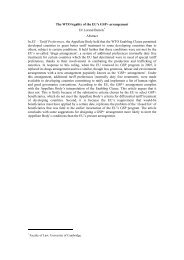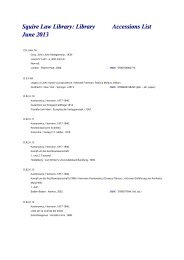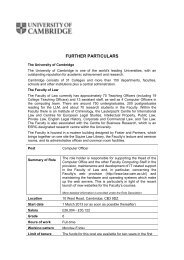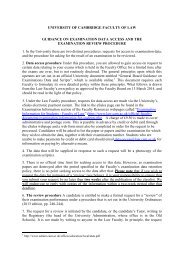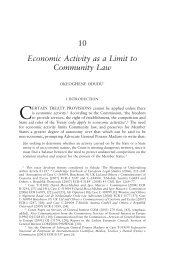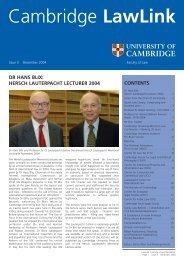start the download - Faculty of Law - University of Cambridge
start the download - Faculty of Law - University of Cambridge
start the download - Faculty of Law - University of Cambridge
You also want an ePaper? Increase the reach of your titles
YUMPU automatically turns print PDFs into web optimized ePapers that Google loves.
LL.M. HANDBOOK 2011-2012Short quotations can be included within continuous text (“like this”), but by conventionlonger ones, running to a few lines,are generally separated from <strong>the</strong> main text and indented slightly,(like this).FootnotesFootnotes enable you to cite <strong>the</strong> authority for a statement made in <strong>the</strong> text, to make crossreferencesto o<strong>the</strong>r parts <strong>of</strong> <strong>the</strong> <strong>the</strong>sis or essay, or to related cases/publications, or to addincidental comments. Their purpose is to enable you to give <strong>the</strong> detail required in anacademically rigorous <strong>the</strong>sis or essay without interrupting <strong>the</strong> flow <strong>of</strong> your argument.Footnotes should be numbered, ei<strong>the</strong>r within each chapter or section, or (since <strong>the</strong> <strong>the</strong>sis oressay is quite short) continuously through <strong>the</strong> whole text. You can ei<strong>the</strong>r choose to haveyour footnotes at <strong>the</strong> bottom <strong>of</strong> each page, or to show <strong>the</strong>m as “endnotes”, all toge<strong>the</strong>r at<strong>the</strong> end <strong>of</strong> each chapter, or even at <strong>the</strong> end <strong>of</strong> <strong>the</strong> whole <strong>the</strong>sis or essay. The format youadopt is not important, provided that you are consistent.BibliographyIt is essential that you include a comprehensive bibliography, which lists all <strong>the</strong>books, articles and o<strong>the</strong>r published materials referred to in <strong>the</strong> text.The bibliography should be in alphabetical order by author’s name. If you include morethan one item by <strong>the</strong> same author, <strong>the</strong>n put <strong>the</strong>m in date order; if <strong>the</strong> author and date are<strong>the</strong> same, put <strong>the</strong>m in alphabetical order by <strong>the</strong> first letter <strong>of</strong> <strong>the</strong> title.Where a book or report is published in <strong>the</strong> name <strong>of</strong> an organisation and not attributed to anindividual author, it should appear under <strong>the</strong> name <strong>of</strong> <strong>the</strong> organisation (e.g. H for HomeOffice, J for Justice, Department <strong>of</strong>, T for Treasury, Her Majesty’s). Do not worry if it is notentirely obvious how to list an organization (eg. is it C for Commons, House <strong>of</strong>, or H forHouse <strong>of</strong> Commons?). Make a reasonable decision and stick to it consistently.Always give references in full in <strong>the</strong> bibliography. This means giving <strong>the</strong> author’s surnameand forename(s) or initial(s), <strong>the</strong> full title <strong>of</strong> <strong>the</strong> publication, and <strong>the</strong> date <strong>of</strong> publication. Witha book you should also give <strong>the</strong> place <strong>of</strong> publication and <strong>the</strong> publisher’s name, and (whereappropriate) specify <strong>the</strong> edition to which you are referring. With an article from a periodical,you should give <strong>the</strong> date and volume number, and <strong>the</strong> page number at which <strong>the</strong> articlebegins (and, ideally <strong>the</strong> page number at which it ends).If you are citing a substantial number <strong>of</strong> cases or statutory materials, it is helpful to list <strong>the</strong>sein a Table <strong>of</strong> Cases and Table <strong>of</strong> Statutes separate from <strong>the</strong> main bibliography. A Table <strong>of</strong>Cases will normally be alphabetical. A Table <strong>of</strong> Statutes may be ei<strong>the</strong>r alphabetical orchronological.Citation <strong>of</strong> TextsWhen you refer to publications in your <strong>the</strong>sis or essay, it is unnecessary and distracting to<strong>the</strong> reader if you include full, detailed references (including place <strong>of</strong> publication, etc.) in <strong>the</strong>28



